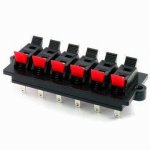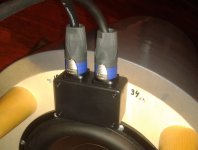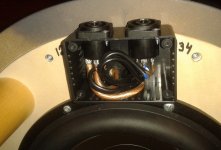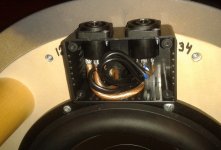6-way trailer cable is a great idea, and one I wish I'd thought of. I'm using three separate fig-8 cables, braided together and terminated with 8-pole speakons at each end - my wife jokes that I have Celtic cables. Both the speakers and the amps (DIY) have 8-pole connectors. I used a heavier pair for the bass.
I managed to cram 6 channels into a single 3U rack case, but it is an extremely tight fit with all the power supply crap (2x300VA+20VA toroids, 0.1F filters, regulated boost-supply for the bass amps, soft-start and remote relay), plus a microcontroller and balanced-input board. It's not as quiet as it should be yet, but I really wanted to avoid multiple termination at the amplifier end in order to prevent tweeter-exploding accidents, and to minimise rack volume consumed (it's a multi-channel home-theatre system).
Is there a standard pin-assignment that people use for speakons? I'm using 1 for bass, 2 for mid and 3 for tweets, 4 NC.
I managed to cram 6 channels into a single 3U rack case, but it is an extremely tight fit with all the power supply crap (2x300VA+20VA toroids, 0.1F filters, regulated boost-supply for the bass amps, soft-start and remote relay), plus a microcontroller and balanced-input board. It's not as quiet as it should be yet, but I really wanted to avoid multiple termination at the amplifier end in order to prevent tweeter-exploding accidents, and to minimise rack volume consumed (it's a multi-channel home-theatre system).
Is there a standard pin-assignment that people use for speakons? I'm using 1 for bass, 2 for mid and 3 for tweets, 4 NC.
Easily shorted out, though.
That's why SpeakOn's so nice - very low contact resistance (I didn't see any figures on your site), plenty of current capacity, won't short out, and you can quad-amp down a single connection.
When electrical shorts out on our planes they erupt into a violent chemical fireball. This happens from time to time, but I do not know of any from a short. Simply by pushing the power limits, especially during the very hot summer months we experience can cause the above reaction even well after power is turned off. Know two people that paid the price ignoring LiPo battery limitations and proper safety proceedures power off in one case and battery by itself left on the workbench after use. One lost his Mercedes and the other lost the entire garage and that side of the house.
Reason I mention these (again) is due to the exceedingly low contact resistance high power electric rc demands. Which I have yet to see anything from the audio field come close to for the cost.
You would have to be referred to RCGroups forums where they openly discuss such research. Before they had their own brand, they audited the entire field to find out why many of their high power speed controls were failing. Forums also have the results from that testing. Remember RC is another world where weight counts and performance is beyond extreme. I also suggest this because this is DIY audio! 😉
I am not affiliated with CC in any way and do not promote all of their products, but do own many. 🙂
There is another advantage to using doubled up cores for the bass driver.
The spare poles in the speakons are in parallel.
The losses across the speakon connections are halved as well.
The spare poles in the speakons are in parallel.
The losses across the speakon connections are halved as well.
Yes, I wouldn't be surprised if the connector is the most resistive part of the wiring so it would definately be an advantage.
Of course, I could just connect a single pair of cores to four pins (2 each), but that could create one of those leads designed to kill amps/drivers if it ever got used in a different setup - and probably by me when i've had time to forget. So I think if I double up on the pins I'll also double up the cores and keep it all 1:1.
Cheers
kev
Of course, I could just connect a single pair of cores to four pins (2 each), but that could create one of those leads designed to kill amps/drivers if it ever got used in a different setup - and probably by me when i've had time to forget. So I think if I double up on the pins I'll also double up the cores and keep it all 1:1.
Cheers
kev
be aware the way Speakon make contact functions very much the same as this older type speaker terminal
not that there is anything wrong with them either 🙂
but the only reason to use Speakon would be for 'practical reasons', safety, etc
The only similarity is spring loading. The speakons have a wiping motion (clears the oxides off) compressing a cylindrical contact, whereas the old connectors pictured tend to make a crappy point-contact with a little pressure.
... whereas the old connectors pictured tend to make a crappy point-contact with a little pressure.
yes, but not all of them 😉
but like any other type terminals, they should be used correctly
or else anything will fail sooner or later
in any case, they are certainly 'low mass' connectors 😀 ... a perfect tweeter terminal maybe

its quite funny that PRO woofers also use similar spring load terminals

btw, are Speakons maybe intended to be used, and used, again and again ... and then replaced ?
I chose Neutrik speakons for my 4-way AINOs. For a 3-way you can use one 4-pin and one 2-pin speakon. Speakons are the easiest way to keep track of positioning and connecting is easy if one has to disconnect the speaker often. My diy-amplifier has also speakon outs, but amplifier end can have the best connectors that suit the amp.
I used a small plastic box in the bottom of the speaker box to assemble connectors.
I used a small plastic box in the bottom of the speaker box to assemble connectors.
Attachments
Those look very neat; good stuff!
Yeah, its mainly the elegant/practical/compact way that the speakons work which appeals to me; there must be many, many ways of getting decent electrical connections.
I vaguely know someone who does the lights and sound for a local venue, which is how I first came across the speakons (and powercons, which I also like a lot). Apparently they last a very long time in that role so I'm sure that their mechanical properties are more than enough for my application. The electrical ones should be good enough too - especially if I double-up the bass cores.
Besides, I just ordered some so the decision is made 🙂
Cheers
Kev
Yeah, its mainly the elegant/practical/compact way that the speakons work which appeals to me; there must be many, many ways of getting decent electrical connections.
I vaguely know someone who does the lights and sound for a local venue, which is how I first came across the speakons (and powercons, which I also like a lot). Apparently they last a very long time in that role so I'm sure that their mechanical properties are more than enough for my application. The electrical ones should be good enough too - especially if I double-up the bass cores.
Besides, I just ordered some so the decision is made 🙂
Cheers
Kev
be aware the way Speakon make contact functions very much the same as this older type speaker terminal
not that there is anything wrong with them either 🙂
but the only reason to use Speakon would be for 'practical reasons', safety, etc
Going by figures published by the manufacturers SpeakOns have about 1/10 the contact resistance of those.
It's 20mOhm for those speaker terminals and <3mOhm for SpeakOns.
Neutrik gives the contact resistance after a lifetime of use ie after 5000 mating cycles.
I have no idea at which point in their lifetime the spring terminals were tested.
The Neutrik contacts are self-cleaning and made of silver-plated brass.
 😀 but try counting in the number of connection needed
😀 but try counting in the number of connection needed design and function is clever, and good, but the materials are not
easy to improve, but that is off topic
I used a small plastic box in the bottom of the speaker box to assemble connectors.
looks neat
 and tight 😱
and tight 😱Besides, I just ordered some so the decision is made 🙂
Cheers
Kev
I think all the Speakon cable connectors have screw terminals internally
but the chassis connector can have either spade or screw terminal
inside a speaker or amp I would definate use spades for safety reasons
Attachments
Speakon cable connectors are designed so that you can either use the screws to hold the cable or solder it.
So I gather that if you chose to solder the connections made by a speakon are exactly the same as those spring terminals ie one.
So I gather that if you chose to solder the connections made by a speakon are exactly the same as those spring terminals ie one.
My chassis/female connectors are made by Neutrik and there are no srews, just soldering tabs. The shop did not have other models in stock.
There are other models, look here speakON Chassis Connectors - Neutrik
There are other models, look here speakON Chassis Connectors - Neutrik
Last edited:
looks like the heavy duty STX series does not have screw terminals
but if having doubts about what is available, the Overview pdf document helps
but if having doubts about what is available, the Overview pdf document helps
The chassis sockets I ordered definitely have spade/solder lugs, I don't know about the internals of the line plugs but they aren't heavy duty so I'd expect them to have the standard screw terminals. That would suit me as I may need to pass the cable through a small hole, so the ability to remove a plug easily in the future would be a benefit.
I could use spades for the chassis sockets, it would make future alterations neater and possibly be more convenient when building it. Although... I generally feel that solder makes a better and more secure joint so thats still a possibility; I've got some heat-shrink that could insulate the joints if safety is a concern at these voltages.
Cheers
Kev
I could use spades for the chassis sockets, it would make future alterations neater and possibly be more convenient when building it. Although... I generally feel that solder makes a better and more secure joint so thats still a possibility; I've got some heat-shrink that could insulate the joints if safety is a concern at these voltages.
Cheers
Kev
... I generally feel that solder makes a better and more secure joint so thats still a possibility
Cheers
Kev
no
soldering a thick wire to a flat surface is not very good at all
much better to solder the wire to a spade connector, and the just mount
just use bare spade connectors without the isolation
you can cut and modify it to suit the cable any way you like
and maybe make it safe with shrink tube afterwards
but man, just getting the right size spade connector is sometimes tricky
Yeah, generally in that sort of joint I split the strands and essentially bury the lug between them, soldering both sides generously so that it becomes a solid lump of metal enclosing the lug rather than just being tacked onto one side of it.
But thats mainly been beneficial in applications where vibration and damp are an issue, and it isn't the most professional or prettiest to look at. So I can see the attraction of spade connectors for my amp which should be in a much kinder environment.
Hmm, though if the spades aren't a common size I will probably need to find some.
Cheers
Kev
But thats mainly been beneficial in applications where vibration and damp are an issue, and it isn't the most professional or prettiest to look at. So I can see the attraction of spade connectors for my amp which should be in a much kinder environment.
Hmm, though if the spades aren't a common size I will probably need to find some.
Cheers
Kev
imo ... one problem with most cable soldering is the wire part between solder and no solder
that is where it often breaks
but especially an issue wirth the smaller size cables
I expect the spade connector should be 4.7/5.0 x 0.5
a common standard, but most are 6.0/6.3 x 0.6
strangely, I have never liked the spade connectors
that is where it often breaks
but especially an issue wirth the smaller size cables
I expect the spade connector should be 4.7/5.0 x 0.5
a common standard, but most are 6.0/6.3 x 0.6
strangely, I have never liked the spade connectors

Soldering to the lug as Juhazi has done is totally fine and will last for ever if the wires are supported inside the box and not left to flap hanging off the connector.
I've been doing soldering them for over 15 years and not had a failure. The lugs are 4.8mm if you want to use crimps, but the soldering is better IMO.
I think at many times this thread has got carried away by some posters! The original proposal was all good.
I've been doing soldering them for over 15 years and not had a failure. The lugs are 4.8mm if you want to use crimps, but the soldering is better IMO.
I think at many times this thread has got carried away by some posters! The original proposal was all good.
- Status
- Not open for further replies.
- Home
- Loudspeakers
- Multi-Way
- 6-way speaker cable



